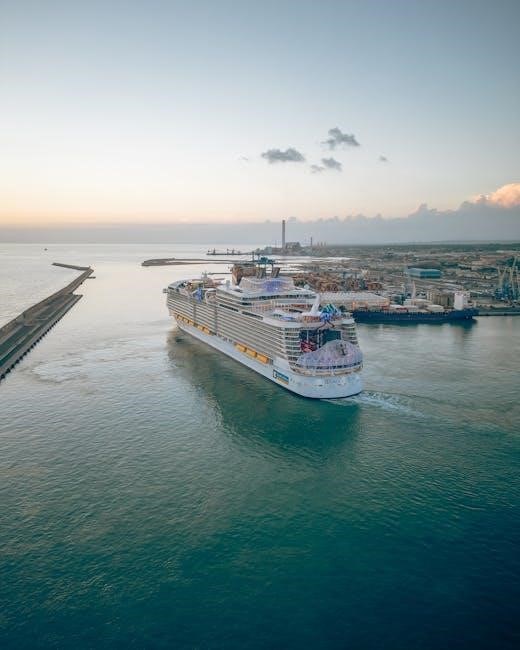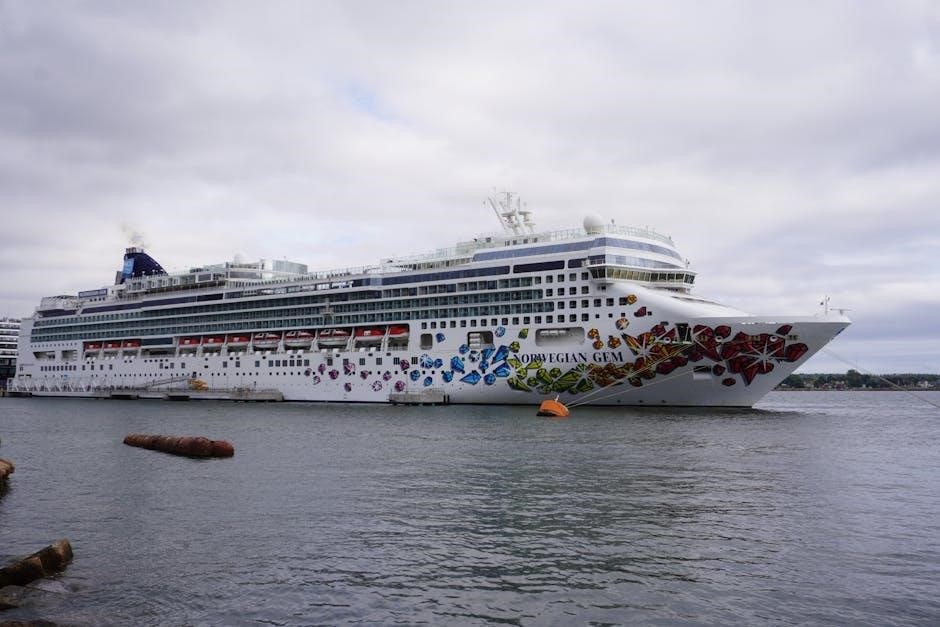The Port of Tyne, located in northeast England, is a vital maritime gateway connecting regional and international trade routes. It plays a crucial role in the local economy, supporting various industries and passenger services. The port is known for its efficient logistics and modern facilities, ensuring smooth operations for cargo and cruise vessels alike. For travelers and logistics planners, accessing up-to-date maps and departure schedules is essential for navigating the port effectively. This guide provides comprehensive insights into the Port of Tyne, including its history, operations, and resources for seamless navigation.
1.1 Overview of the Port of Tyne
The Port of Tyne, situated in northeast England, is a bustling hub for cargo, cruise ships, and ferries. It serves as a gateway for trade and tourism, offering efficient logistics and modern facilities; The port handles a wide range of vessels, from commercial cargo ships to passenger ferries, ensuring smooth operations. Its strategic location along the River Tyne makes it a vital link for regional and international trade. Real-time tracking and PDF maps are available for seamless navigation and planning.
1.2 Historical Significance of the Port
The Port of Tyne has a rich history dating back centuries, serving as a vital trade and maritime hub in northeast England. During the Industrial Revolution, it became a key center for coal exports and shipbuilding, driving regional economic growth. Its strategic location on the River Tyne facilitated connections to global markets, making it a cornerstone of the UK’s maritime heritage. Today, the port continues to honor its legacy while adapting to modern demands.
1.3 Economic Importance of the Port
The Port of Tyne is a cornerstone of northeast England’s economy, supporting trade, logistics, and tourism. It handles diverse cargo, from bulk goods to renewable energy equipment, while also accommodating passenger cruises. The port generates significant employment opportunities and contributes to regional economic growth. Its strategic location enhances connectivity, making it a vital hub for both domestic and international commerce, ensuring the region’s prosperity and industrial competitiveness in a global market.

Understanding Port of Tyne Departures
The Port of Tyne manages a variety of vessel movements, including cargo ships, ferries, and cruise liners. Departures are frequent, ensuring efficient trade and passenger travel. Modern facilities and strategic planning enable smooth operations, while maps and schedules provide essential navigation support for all users.
2.1 Types of Vessels Using the Port
The Port of Tyne accommodates a diverse range of vessels, including cargo ships, ferries, and cruise liners. Cargo vessels transport goods like coal, timber, and containers, supporting regional trade. Ferries provide passenger and vehicle transport across the Tyne, while cruise liners contribute to tourism. Additionally, smaller boats and fishing vessels operate within the port, highlighting its versatility in catering to various maritime needs. This diversity underscores the port’s importance as a multifunctional hub.
2.2 Frequency of Departures
The Port of Tyne experiences a steady flow of departures, catering to both cargo and passenger traffic. Cargo vessels operate on scheduled timelines, while ferries and cruise liners maintain regular departure intervals. Weather and tidal conditions can influence departure frequencies, ensuring safe navigation. The port’s efficient management allows for timely arrivals and departures, supporting its role as a key regional and international trade hub. This regularity is crucial for maintaining smooth maritime operations.
2.3 Key Routes and Destinations
The Port of Tyne serves as a gateway to major European and global destinations, with frequent departures to key ports in the North Sea, Baltic Sea, and Mediterranean regions. Rotterdam, Hamburg, and Barcelona are among the primary routes, facilitating trade and tourism. These connections underscore the port’s strategic importance in supporting regional and international commerce, ensuring efficient logistics and travel opportunities for both cargo and passengers.
Accessing Live Departure Information
Stay updated on Port of Tyne departures through official websites, mobile apps, or real-time tracking systems. These sources provide accurate schedules, delays, and vessel movements for efficient planning.

3.1 Official Sources for Departure Data
The Port of Tyne provides official departure data through its website and mobile app. These platforms offer real-time updates, schedules, and vessel tracking. Additionally, the port authority shares information via social media and email newsletters. For the most accurate and reliable data, users are encouraged to rely on these official channels, ensuring they have the latest updates on departures, delays, and any operational changes. This helps in planning journeys and logistics efficiently.
3.2 Third-Party Apps and Websites
Several third-party apps and websites offer Port of Tyne departure data, providing real-time updates and interactive features. Platforms like MarineTraffic or Shipfinder allow users to track vessel movements and view schedules. These tools often include maps, notifications, and detailed ship information. While convenient, they should be used alongside official sources for cross-verification. They cater to both casual users and professionals, enhancing the overall navigation and planning experience for port-related activities.
3.3 Real-Time Tracking Technologies
Real-time tracking technologies, such as AIS (Automatic Identification System) and GPS, enable precise monitoring of vessel movements at the Port of Tyne. These systems provide live updates on ship locations, speeds, and estimated arrival times. Integrated with electronic charts, they enhance navigation planning and safety. Users can access this data through dedicated software or apps, ensuring accurate and timely information for efficient port operations and environmental monitoring, reducing delays and improving overall maritime efficiency.

The Role of Maps in Port Navigation
Maps are essential for navigating the Port of Tyne, providing clear layouts of terminals, berths, and facilities. They guide passengers and logistics teams efficiently, ensuring smooth operations.
4.1 Importance of Port Maps for Passengers
Port maps are vital for passengers, providing clear navigation through terminals, parking areas, and facilities. They help locate check-in points, departure gates, and amenities efficiently. Maps also offer real-time updates on departures and delays, ensuring passengers stay informed. This resource enhances the overall travel experience, reducing stress and saving time. Accessing a PDF map of the Port of Tyne allows passengers to plan their journey seamlessly, making it an indispensable tool for smooth port navigation.
4.2 Using Maps for Logistics and Planning
Maps are essential for logistics and planning at the Port of Tyne, enabling efficient route optimization and resource allocation. They provide detailed layouts of terminals, parking areas, and access points, helping logistics teams manage operations smoothly. By integrating with departure schedules, maps allow for better planning of cargo movements and personnel deployment. This ensures timely deliveries and minimizes operational delays, making maps a critical tool for logistics professionals operating at the port.
4.3 Integration of Maps with Departure Schedules
Integrating maps with departure schedules enhances operational efficiency at the Port of Tyne. Real-time tracking allows visualization of vessel movements, ensuring timely departures. This synchronization aids logistics teams in optimizing routes and reducing delays. Passengers benefit from accurate information, enabling better travel planning. The combined use of maps and schedules streamlines port operations, improving overall productivity and user experience.
Obtaining the Port of Tyne Map in PDF Format
The Port of Tyne map in PDF format is available for download through official channels, ensuring users have up-to-date information for navigation and planning purposes.
5.1 Official Channels for Downloading the Map
The Port of Tyne map in PDF format can be downloaded directly from the official Port of Tyne website. This ensures users access the most accurate and up-to-date information. The website typically features a dedicated section for downloads, where visitors can find the map alongside other useful resources. Additionally, the Port Authority may provide the map through their customer service channels upon request. This official method guarantees reliability and convenience for planning and navigation purposes.
5.2 Tips for Reading and Using the PDF Map
When using the Port of Tyne map in PDF format, start by familiarizing yourself with the layout and symbols. Zoom in on specific areas for detailed information about terminals and routes. Use the legend to understand markings for cargo zones, passenger terminals, and parking areas. Ensure your device has a PDF reader with zoom and search functions for easy navigation. Regularly check for updates to the map to ensure you have the latest version for accurate planning and navigation.
5.3 Customizing the Map for Specific Needs

To tailor the Port of Tyne map for your needs, consider adding layers or highlighting specific routes and terminals. Use digital tools to mark important locations like parking areas or passenger terminals. For logistics planning, overlay departure schedules on the map for better coordination. If printing, ensure the scale is adjusted for clarity. Save multiple versions of the map for different purposes, such as cargo logistics or passenger navigation, to enhance usability and efficiency.

Navigating the Port of Tyne
Navigating the Port of Tyne involves identifying key landmarks, terminals, and access points. Plan routes in advance, consider parking options, and adhere to security protocols for smooth movement.
6.1 Key Landmarks and Terminals
The Port of Tyne features prominent landmarks like the Tyne Bridge and historic quaysides. Major terminals include the Northumbrian Quay and Tyne Dock, handling cargo and passenger services. The port’s layout is designed for efficient navigation, with clear signage guiding visitors to terminals, parking, and amenities. Key access points like the Royal Quayside and South Shields Ferry Terminal are essential for both logistics and passenger travel, ensuring smooth operations and accessibility.
6.2 Parking and Access Points
The Port of Tyne offers convenient parking facilities near major terminals, ensuring easy access for passengers and logistics personnel. Designated parking areas are clearly marked on the port map, guiding visitors to the nearest lots. Access points are well-signposted, with main entry and exit routes highlighted for efficient navigation. For a seamless experience, travelers are advised to check the map for parking locations and plan their arrival accordingly to avoid delays.
6.3 Security and Safety Procedures
The Port of Tyne maintains robust security and safety measures to ensure a secure environment for all users. Access points are monitored with CCTV, and ID checks are mandatory for authorized personnel. Baggage screening and regular patrols are conducted to prevent unauthorized activities. Emergency response plans are in place, including evacuation routes and first aid stations. Visitors are advised to follow safety guidelines and report any suspicious activity to port authorities immediately.
Weather and Tidal Information
Weather and tidal conditions significantly impact Port of Tyne operations, affecting departure schedules and navigation. Accurate forecasts and real-time data are essential for safe and efficient maritime activities.

7.1 Impact of Weather on Departures
Weather conditions, such as storms, strong winds, and fog, can significantly delay or disrupt Port of Tyne departures. Adverse weather may force vessels to wait or reroute, ensuring safety. Real-time weather updates are crucial for planning and avoiding operational disruptions. Authorities monitor conditions closely to minimize impacts on schedules and ensure smooth maritime operations. Accurate forecasts help stakeholders prepare for potential delays, maintaining efficiency in port activities.
7.2 Tidal Patterns and Their Effects
Tidal patterns significantly influence Port of Tyne operations, as fluctuating water levels affect vessel movements and docking. High and low tides determine safe navigation windows, with extreme tides occasionally causing delays. The port closely monitors tidal cycles to optimize schedules and ensure efficient cargo handling. Understanding tidal impacts is crucial for logistics planning, as deviations can require adjustments in departure and arrival times to maintain operational efficiency and safety.

7.3 Sources for Real-Time Weather Updates
For real-time weather updates impacting Port of Tyne operations, rely on trusted sources like the UK Met Office, local weather stations, and maritime apps. The Met Office provides detailed forecasts, while apps like Weather Underground offer live data. Additionally, the port’s official website and social media channels often share weather-related advisories. These sources help ensure safe and efficient planning for departures, arrivals, and logistics, minimizing disruptions caused by adverse conditions.
Port of Tyne Departures Today
Today, November 12, 2025, the Port of Tyne schedules multiple departures, including cargo and passenger vessels; Check live updates for delays or cancellations due to weather conditions.
8.1 Current Departure Schedule
On November 12, 2025, the Port of Tyne features multiple departures, including cargo ships heading to European ports and passenger ferries to nearby destinations. Vessels are scheduled throughout the day, with peak activity during morning and late afternoon. Use the official Port of Tyne map PDF to identify terminal locations and plan your visit. Real-time trackers provide updates on departure times, ensuring efficient travel planning for both cargo and passenger services.
8.2 Expected Delays or Cancellations
On November 12, 2025, the Port of Tyne reports no major cancellations, but minor delays are expected for two cargo vessels due to weather conditions. Passenger ferries are operating on schedule. Check the live departure tracker or the official Port of Tyne map PDF for real-time updates. Plan your visit by allowing extra time for potential disruptions, especially during peak hours or adverse weather.
8.3 Special Notices or Alerts
As of today, the Port of Tyne has issued a notice regarding planned maintenance at Terminal 2, affecting cargo operations until 6 PM. Additionally, passengers are advised to check weather updates, as strong winds may cause minor delays. Security protocols remain heightened, and travelers are reminded to arrive earlier for screenings. For the latest alerts, refer to the official Port of Tyne map PDF or their live departure tracker.
Future Developments and Expansion Plans
The Port of Tyne is planning infrastructure upgrades, including new berths and green technologies, to enhance efficiency and sustainability, aligning with global maritime trends and demands.
9.1 Upcoming Infrastructure Projects
The Port of Tyne is undergoing significant infrastructure upgrades, including the expansion of berths and the installation of green technologies to reduce carbon emissions. Plans also include modernizing cargo handling facilities and enhancing passenger terminals to accommodate growing demand. These projects aim to improve efficiency, sustainability, and capacity, ensuring the port remains competitive in the global maritime industry while supporting regional economic growth and environmental goals.
9.2 Technological Advancements in Port Operations
The Port of Tyne is embracing cutting-edge technologies to enhance operational efficiency. Automation systems, such as AI-driven cargo management and real-time tracking via IoT devices, are being implemented to streamline processes. Digital platforms now provide live updates on departures and vessel movements, improving transparency for stakeholders. Additionally, the port is integrating sustainable technologies, including solar-powered infrastructure and electric vehicle charging points, to reduce its environmental footprint and align with global green initiatives.
9.3 Sustainability Initiatives
The Port of Tyne is committed to sustainability, implementing eco-friendly practices to reduce its environmental impact. Initiatives include transitioning to solar-powered infrastructure and expanding electric vehicle charging points. The port aims to minimize emissions and waste through efficient resource management. Partnerships with environmental organizations and adherence to ISO 14001 certification underscore its dedication to sustainable operations, ensuring a greener future for maritime activities while maintaining operational excellence.

Contact Information and Support
For inquiries, contact the Port of Tyne Authority at +44 191 455 2100 or email info@portoftyne.co.uk. Visit their office at Tyne Dock, South Shields, NE33 1RD.
10.1 Port Authority Contact Details
The Port of Tyne Authority can be reached at +44 191 455 2100 or via email at info@portoftyne.co.uk. Their office is located at Tyne Dock, South Shields, NE33 1RD. For general inquiries, visit their official website at www.portoftyne.co.uk. The authority provides assistance with port operations, departures, and map downloads, ensuring efficient support for all users.
10.2 Customer Service and Enquiries
The Port of Tyne’s customer service team is available to assist with enquiries regarding departures, maps, and general port operations. For immediate support, call +44 191 455 2100 or email customerservice@portoftyne.co.uk. Enquiries can also be submitted via the official website’s contact form. The team operates Monday to Friday, 9 AM to 5 PM, providing timely and accurate information to ensure a smooth experience for all users.
10.3 Emergency Contact Numbers
In case of emergencies, contact the Port of Tyne’s 24/7 emergency line at +44 798 187 1111. For fire or medical emergencies, dial 999. Security concerns can be reported to security@portoftyne.co.uk. These contacts ensure immediate assistance for accidents, incidents, or urgent situations within the port premises. Keep these numbers handy for quick access during critical moments.

Common Issues and Solutions
Common issues include map download failures, incorrect departure times, and navigation difficulties. Solutions involve checking internet connectivity, verifying data sources, and contacting support for assistance promptly.
11.1 Troubleshooting Map Downloads
Common issues with downloading the Port of Tyne map include slow internet speeds, corrupted files, or incorrect links. Ensure a stable connection, use official sources, and try a different browser. If the PDF fails to open, check your reader software is updated. For persistent problems, contact support or attempt the download on another device to resolve the issue effectively and access the map without delays.
11.2 Resolving Departure Time Conflicts
Departure time conflicts at the Port of Tyne can be resolved by checking live schedules and real-time tracking tools. Ensure you verify the latest timetables on official sources or third-party apps. If discrepancies arise, contact customer support for clarification. Using the Port of Tyne map PDF can also help plan your route effectively, minimizing delays. Always cross-reference information to avoid misunderstandings and ensure smooth travel or logistics arrangements.
11.3 Addressing Navigation Challenges
Navigating the Port of Tyne can be simplified by using the official map PDF, which highlights key landmarks and terminals. Ensure your device has the latest map downloaded and refer to real-time departure schedules. For GPS navigation, enter the correct coordinates for parking and access points. If unsure, contact the port’s customer service for assistance. Familiarizing yourself with the layout beforehand can significantly reduce navigation challenges and ensure a smooth experience.
The Port of Tyne excels in efficient operations, with maps and real-time data enhancing navigation. Utilize these resources for a seamless experience and future planning.
12.1 Summary of Key Points
The Port of Tyne is a vital hub for trade and travel, offering efficient departures and accessible resources. Utilize official maps and real-time data for seamless navigation. Downloading the PDF map provides detailed insights, while staying updated on schedules ensures smooth planning. By leveraging these tools, users can optimize their experience, whether for logistics or passenger travel. Explore further to maximize the benefits of the Port of Tyne’s resources and services.
12.2 Final Tips for Using Port Resources
Always check live departure schedules to avoid delays. Download the official Port of Tyne map in PDF for clear navigation. Use real-time tracking tools to monitor vessel movements. Stay updated on weather and tidal conditions for safe planning. Familiarize yourself with key landmarks and terminals. Follow security protocols and contact support for any assistance. By leveraging these resources effectively, you can ensure a smooth and efficient experience at the Port of Tyne.
12.3 Encouragement for Further Exploration
Exploring the Port of Tyne’s resources, such as its detailed maps and real-time departure schedules, can greatly enhance your experience. By familiarizing yourself with these tools, you can navigate the port with confidence and efficiency. Whether planning a trip or managing logistics, the wealth of information available ensures you stay informed and prepared. Take the time to discover all the port has to offer for a seamless and enjoyable journey.
